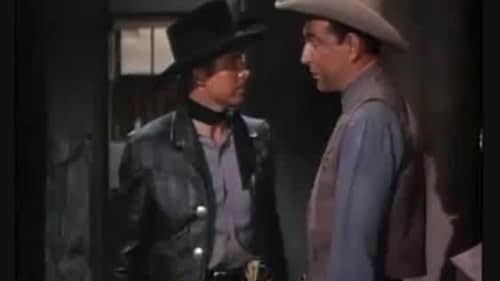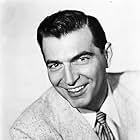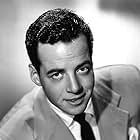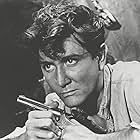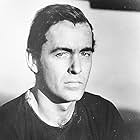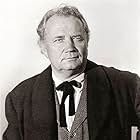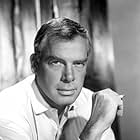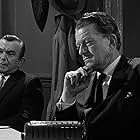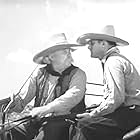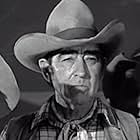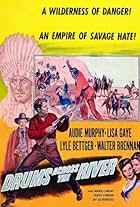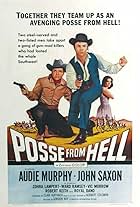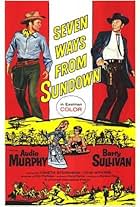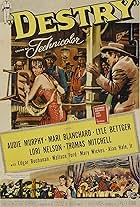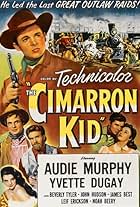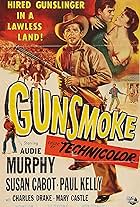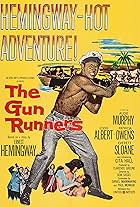Marshal Tyrone and the Silver Kid form an uneasy alliance against a gang of claim jumpers.Marshal Tyrone and the Silver Kid form an uneasy alliance against a gang of claim jumpers.Marshal Tyrone and the Silver Kid form an uneasy alliance against a gang of claim jumpers.
Stephen McNally
- Marshal Lightning Tyrone
- (as Stephen Mc.Nally)
James Anderson
- Rat Face Blake
- (as Kyle James)
Victor Adamson
- Townsman
- (uncredited)
John Albright
- Townsman
- (uncredited)
Carl Andre
- Carl - Claim Jumper
- (uncredited)
Emile Avery
- Posse Member
- (uncredited)
William Bailey
- Townsman
- (uncredited)
Griff Barnett
- Dan 'Pop' Muzik
- (uncredited)
George Bell
- Townsman
- (uncredited)
Stanley Blystone
- Sam
- (voice)
- (uncredited)
Storyline
Did you know
- TriviaThis was Don Siegel's first western, as well as his first film for Universal, which became his home studio in the '60s and '70s.
- GoofsDuring the climactic gunfight where rider Rod Lacy is himself chased on horseback by the marshal and both then dismount to continue shooting at each other, Lacy astonishingly manages to fire 11 shots from what is clearly a revolver pistol (which normally fires only 6) before an attempted 12th shot reveals it to be out of ammunition, and only then is Lacy forced to reload it - he is out of frame briefly whilst on his galloping horse (the camera cuts to the chasing marshal) but could not have conceivably re-loaded during that very short time, and at no point throughout is he shown to be carrying 2 guns.
- Quotes
Marshal Lightning Tyrone: [to Blake] If you're in Silver City after sundown, Rat Face, I'll throw you in jail.
[He throws him through store window]
- ConnectionsReferenced in Hollywood Remembers Lee Marvin (2000)
Featured review
Duel At Silver Creek is a co-starring vehicle for Audie Murphy, the last of the great B-movie western stars, briskly directed by the great Don Siegel. The baby-faced Murphy, who made 46 films in 20 years before dying in a plane crash, was the most decorated soldier of World War II. (In fact the star's appearance can be taken as an ironic comment on visual stereotyping as John Wayne, who looked every inch a hero, avoided the call up entirely.) For the most part Murphy starred in second-rate vehicles with second-rate talent. A few titles have stood the test of time, such as Red Badge Of Courage (1951) or The Unforgiven (1960) both directed by Huston, or Boetticher's fine A Time For Dying (1969), also the actor's last film. By and large, however, Murphy suffered from a bland screen persona which only strong direction and casting could overcome, even if most of his vehicles remain watchable.
Siegel, who went on to direct Dirty Harry (1971) and Charley Varrick (1973) was here at an early stage in his career, but had already made three or four other westerns before this one, his first in colour. Duel At Silver Creek is perhaps the most successful of those so far principally because the director is able to steer events along quickly enough to cover most of the weaknesses inherent in the script, and able to create a cast strong enough to balance out Murphy's presence. It opens as Luke Cromwell and his older partner work a gold claim, only to become the latest victims in a murderous claim-jumping racket. Luke's partner is forced to sign over the property while, after an exciting chase and shootout, Cromwell only narrowly escapes his own abrupt end. Soon he resurfaces as 'the Silver Kid', the baby faced gun-toting gambler, in a town where Marshall 'Lightning' Tyrone is also after the crooks. Chief among the suspects is Johnny Sombrero, a taunting thug who may be in league with the outlaws. The Marshall begins to develop an infatuation with the Opal Lacy (Susan Cabot), sister of the chief villain who by this time has also arrived in town. Meanwhile, handicapped by a wound, Tyrone is forced to turn to the Kid when the existing deputy is shot, and the two form an uneasy partnership.
The above plot summary shows just how clichéd many of the plot points of Silver Creek are. A lot of the film reveals its B-movie origins, perhaps chief of which is the cliché of the crippled lawman. As the Marshall nurses his secret weakness, still hoping the keep the 'indian sign' over the ambitious Sombrero, the obvious irony is his reluctant need for the younger man to come to his aid. To this one might add the over-familiar dichotomy between the woman of the world (Opal) and the good girl (Dusty), the hiding of a key witness in a secret cave, as well as Silver Kid's conspicuous white handled armaments - conventions familiar to those versed in the genre. Despite these commonplace matters, Siegel still manages to turn in one or two striking scenes, such as when the sexually provocative Opal abruptly strangles a wounded man awaiting the doctor (thereby demonstrating the dead end nature of her charms) or when Pop, the original deputy, is shot and left facedown in the rain. Siegel's film has the advantage of co-starring Murphy with Stephen McNally as the Marshall and, after the opening sequence; they more or less spend equal time on screen together. McNally's maturity, both as actor and character, balances out the Kid's inexperience nicely. In particular the older actor's voice-over (a relatively unusual device in an otherwise straightforward western of this sort), places a lot of the action in context, adding an authoritative framework to somewhat flimsy proceedings. It also has the useful advantage of not requiring the Kid to explain himself too often, where a lack of gravitas would be a disadvantage. Several times explicit reference is made to the Murphy's youthful appearance, so at odds with his lethal potential. "He didn't have the face of a killer," says the Marshall on first sight of his ally-to-be, "but I noticed his hands were quick and sure." In fact the Marshall's authoritative voice-over like this, grounding events in descriptive seriousness, relates the film to a genre form that would be very familiar to contemporary viewers: the radio western. (I don't think Murphy ever did a series on air). In radio drama conventions of the period, a single male narrator frequently might 'carry' events by the force of his personality, his voice the sole source of moral judgment.
Dressed in black leather, self conscious and slightly gauche, the Kid's character and his relation to a mature lawman reminds one of 'Mississippi' in Hawk's far superior El Dorado (1966), played by James Caan, or the Ricky Nelson part in the earlier Rio Bravo (1959). These later roles would be better developed, both in their relationship to the older mentor (Wayne, in both cases) as well as the moral intelligence behind a flashy rig. Set up with double guns, reserved although unnervingly assured, the Silver Kid remains two dimensional, a perception that not even his awkward romancing of Dusty can allay. Fortunately, as well as the strong role of the Marshall to distract us, there are some colourful characters further down the cast list. Notable is Johnny Sombrero (played by actor Eugene Iglesias, looking remarkably like a young Sean Penn) - as well as Tinhorn Burgess an already effective Lee Marvin, then currently working his way up through the ranks of B-heavies to future stardom.
Silver Creek remains excellent entertainment, notably in the vivid DVD reincarnation that revels in a crisp colour picture with a range of vivid colours characteristic of 1950s' film stock. Incidentally, modern viewers will relish lines like (on the Marshall's damaged hand) "It's going to be kinda stiff for a while but you need to keep massaging it," as well as (on Opal's coded attractions) "Women like that are likely to a put a man's shooting iron plum out of action." Others will simply want to buy this and hark back to a less cynical period of western production when, with little psychology and angst, the biggest clue to man's intent was the size of his sombrero.
Siegel, who went on to direct Dirty Harry (1971) and Charley Varrick (1973) was here at an early stage in his career, but had already made three or four other westerns before this one, his first in colour. Duel At Silver Creek is perhaps the most successful of those so far principally because the director is able to steer events along quickly enough to cover most of the weaknesses inherent in the script, and able to create a cast strong enough to balance out Murphy's presence. It opens as Luke Cromwell and his older partner work a gold claim, only to become the latest victims in a murderous claim-jumping racket. Luke's partner is forced to sign over the property while, after an exciting chase and shootout, Cromwell only narrowly escapes his own abrupt end. Soon he resurfaces as 'the Silver Kid', the baby faced gun-toting gambler, in a town where Marshall 'Lightning' Tyrone is also after the crooks. Chief among the suspects is Johnny Sombrero, a taunting thug who may be in league with the outlaws. The Marshall begins to develop an infatuation with the Opal Lacy (Susan Cabot), sister of the chief villain who by this time has also arrived in town. Meanwhile, handicapped by a wound, Tyrone is forced to turn to the Kid when the existing deputy is shot, and the two form an uneasy partnership.
The above plot summary shows just how clichéd many of the plot points of Silver Creek are. A lot of the film reveals its B-movie origins, perhaps chief of which is the cliché of the crippled lawman. As the Marshall nurses his secret weakness, still hoping the keep the 'indian sign' over the ambitious Sombrero, the obvious irony is his reluctant need for the younger man to come to his aid. To this one might add the over-familiar dichotomy between the woman of the world (Opal) and the good girl (Dusty), the hiding of a key witness in a secret cave, as well as Silver Kid's conspicuous white handled armaments - conventions familiar to those versed in the genre. Despite these commonplace matters, Siegel still manages to turn in one or two striking scenes, such as when the sexually provocative Opal abruptly strangles a wounded man awaiting the doctor (thereby demonstrating the dead end nature of her charms) or when Pop, the original deputy, is shot and left facedown in the rain. Siegel's film has the advantage of co-starring Murphy with Stephen McNally as the Marshall and, after the opening sequence; they more or less spend equal time on screen together. McNally's maturity, both as actor and character, balances out the Kid's inexperience nicely. In particular the older actor's voice-over (a relatively unusual device in an otherwise straightforward western of this sort), places a lot of the action in context, adding an authoritative framework to somewhat flimsy proceedings. It also has the useful advantage of not requiring the Kid to explain himself too often, where a lack of gravitas would be a disadvantage. Several times explicit reference is made to the Murphy's youthful appearance, so at odds with his lethal potential. "He didn't have the face of a killer," says the Marshall on first sight of his ally-to-be, "but I noticed his hands were quick and sure." In fact the Marshall's authoritative voice-over like this, grounding events in descriptive seriousness, relates the film to a genre form that would be very familiar to contemporary viewers: the radio western. (I don't think Murphy ever did a series on air). In radio drama conventions of the period, a single male narrator frequently might 'carry' events by the force of his personality, his voice the sole source of moral judgment.
Dressed in black leather, self conscious and slightly gauche, the Kid's character and his relation to a mature lawman reminds one of 'Mississippi' in Hawk's far superior El Dorado (1966), played by James Caan, or the Ricky Nelson part in the earlier Rio Bravo (1959). These later roles would be better developed, both in their relationship to the older mentor (Wayne, in both cases) as well as the moral intelligence behind a flashy rig. Set up with double guns, reserved although unnervingly assured, the Silver Kid remains two dimensional, a perception that not even his awkward romancing of Dusty can allay. Fortunately, as well as the strong role of the Marshall to distract us, there are some colourful characters further down the cast list. Notable is Johnny Sombrero (played by actor Eugene Iglesias, looking remarkably like a young Sean Penn) - as well as Tinhorn Burgess an already effective Lee Marvin, then currently working his way up through the ranks of B-heavies to future stardom.
Silver Creek remains excellent entertainment, notably in the vivid DVD reincarnation that revels in a crisp colour picture with a range of vivid colours characteristic of 1950s' film stock. Incidentally, modern viewers will relish lines like (on the Marshall's damaged hand) "It's going to be kinda stiff for a while but you need to keep massaging it," as well as (on Opal's coded attractions) "Women like that are likely to a put a man's shooting iron plum out of action." Others will simply want to buy this and hark back to a less cynical period of western production when, with little psychology and angst, the biggest clue to man's intent was the size of his sombrero.
- FilmFlaneur
- Sep 27, 2004
- Permalink
- How long is The Duel at Silver Creek?Powered by Alexa
Details
- Runtime1 hour 17 minutes
- Color
- Aspect ratio
- 1.37 : 1
Contribute to this page
Suggest an edit or add missing content

Top Gap
By what name was The Duel at Silver Creek (1952) officially released in India in English?
Answer
